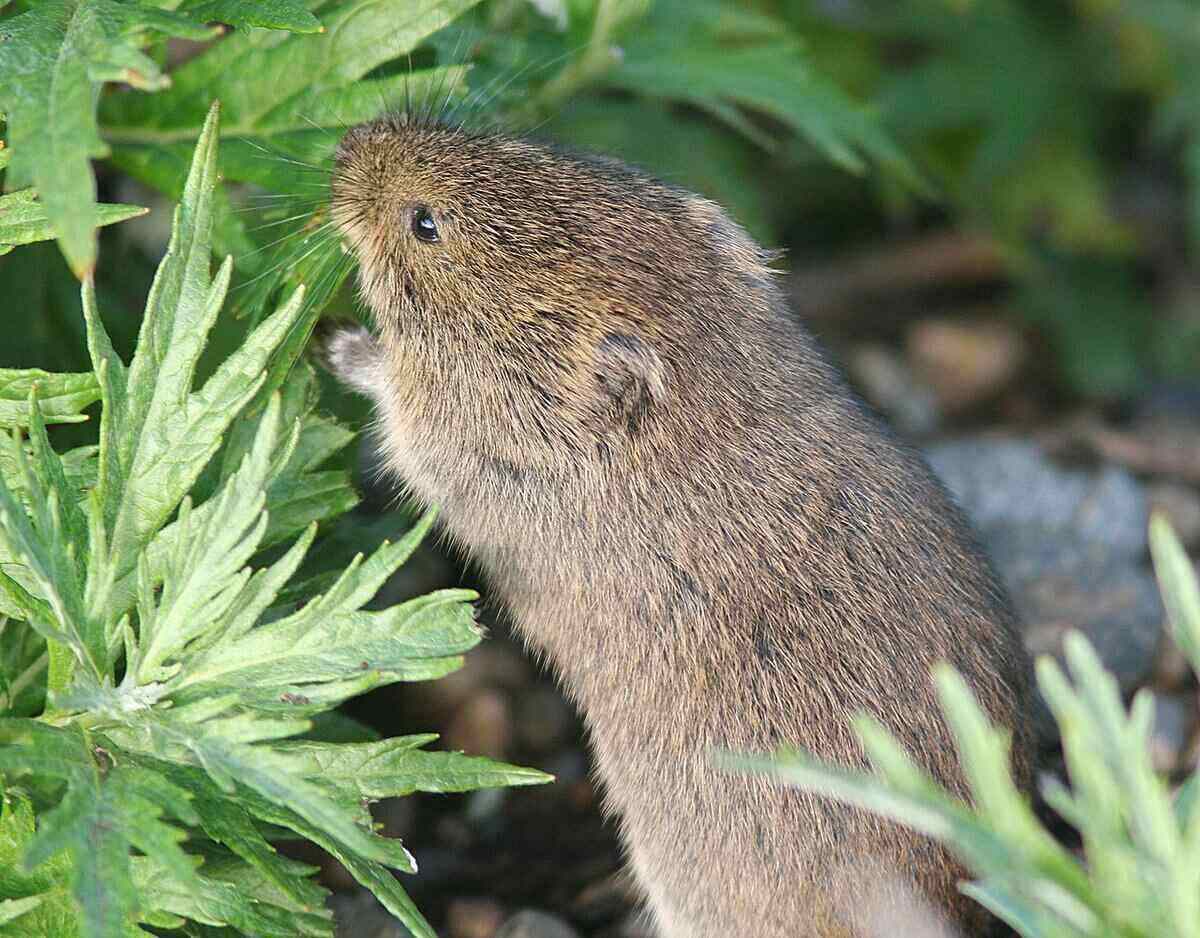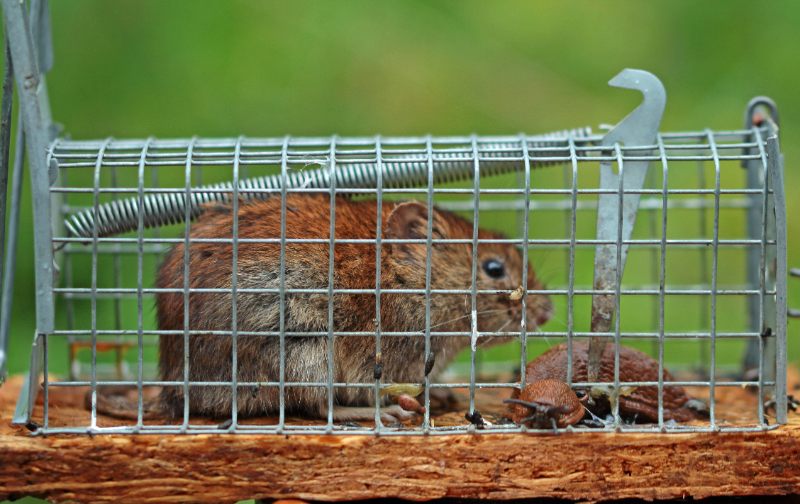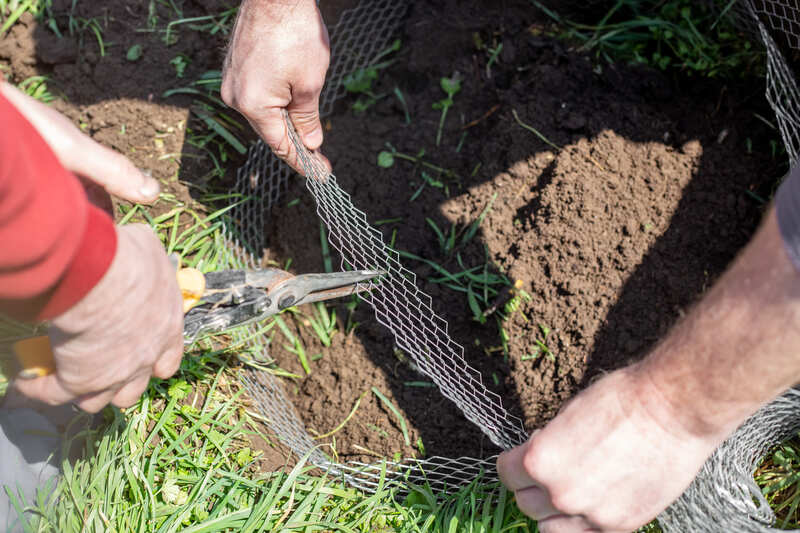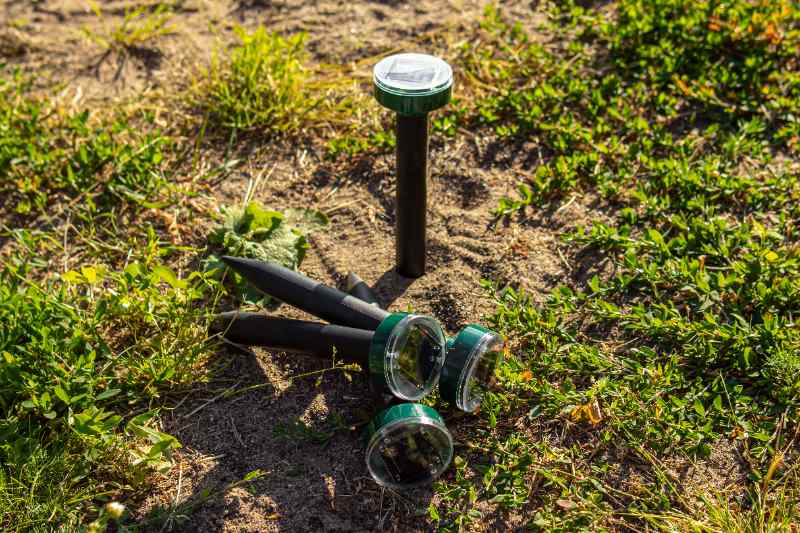
You don’t have to play whack-a-vole to get rid of voles in your yard. We’ll share 7 effective methods you can use, including repellents, traps, physical barriers, and ultrasonic devices.
Voles can cause significant damage to your lawn, as they enjoy munching on grass roots and digging burrows underground. Plus, they can easily invade your yard. Washington State University says 1 pregnant female vole can produce 5 female offspring on a 28-day gestation, and exponentially jump to 3,125 females in less than 5 months.
Hiring a pest control pro can help eliminate voles in yards, but these 7 methods also work:
1. Use Repellents
| Effectiveness: Moderate Difficulty: Easy Cost: Low to moderate, depending on product type Time: A few minutes to set up, but requires reapplication after rain or irrigation |
Vole repellents are effective because they can make your yard taste, smell, or feel unpleasant to voles, prompting them to move elsewhere.
However, some repellents “tend to be relatively expensive,” says Kyle Broderick, associate Extension educator at the University of Nebraska-Lincoln, “and often only provide a short-term solution.”
Common vole repellents include:
- Castor oil-based sprays: When sprayed on the soil, they create an unpleasant smell and taste for voles that drives them to seek other food sources.
- Granular repellents: Sprinkling them along vole runways or garden beds can help create a scent barrier.
- Homemade mixes: A DIY blend of hot pepper, garlic, and water can help deter voles for a few days. Broderick advises reapplying them periodically, especially after rain.
- Predator urine: Available in garden stores, fox and coyote urine can effectively scare the voles away because they will think that these predators are nearby.
While these are not a permanent fix, they’re a great first line of defense, especially when combined with other methods like trapping or barriers.
See Related: How to Repair Vole Damage
2. Trap the Voles

| Effectiveness: High Difficulty: Moderate; requires frequent checking and placement strategy Cost: Low Time: A few days to a week |
If repellents aren’t cutting it and you want to get rid of voles quickly, you can use traps instead. In fact, it’s one of the most effective ways to handle an active infestation, especially during fall or late winter when they are most active.
So, if you notice signs of voles in your yard, you can use the trapping method along with repellents and barriers for lasting results.
Types of vole traps include:
- Snap traps: Using peanut butter, apple slices, or oatmeal as bait, place these snap traps perpendicular to vole runways. To protect non-target animals, you can cover the traps with a box or a PVC pipe.
- Live traps: You can use live traps if you want to capture voles without harming them. And if it’s not against regulations in your area, you can release them several miles away in wooded or grassy areas.
- Multiple-catch traps: If you’re dealing with heavy infestation, multiple-catch traps can catch several voles at once in high-activity zones.
Pro Tip: If you find baby voles in your yard, avoid touching them. Relocating or harming baby voles yourself is illegal in some areas. Instead, contact local wildlife rehabilitators for assistance.
See Related: Voles vs. Moles: How to Tell the Difference
3. Install Physical Barriers

| Effectiveness: High Difficulty: Moderate to high Cost: Moderate, depending on fencing material and area size Time: Up to several hours, depending on the type of barrier |
“Physical barriers can be installed around trees and other vegetation that requires protection,” says Danielle Gunn, agricultural Extension educator at the University of Idaho.
They work by blocking voles from reaching your plants and tunneling through your yard, making this one of the most reliable vole deterrent methods.
Common barrier options include:
- Hardware cloth or wire mesh: Gunn recommends installing 1/4-inch mesh (6 inches deep and extending 14 inches aboveground) around trees and other vegetation. She adds, “To prevent voles from climbing the barrier, try to bend the top at a 90-degree angle.”
- Underground garden fencing: Stop vole tunneling by burying mesh barriers 12 inches deep along the perimeter of raised beds or garden borders.
- Rock or gravel barrier: Discourage digging by making it hard for voles to burrow with a wide gravel moat. Mix course or sharp-edged gravel around plant bases.
4. Attract Natural Predators (Biological Controls)
| Effectiveness: Moderate to high Difficulty: Easy Cost: Low Time: Installing owl boxes and raptor perches can take a few hours |
Sometimes, letting nature do the work is the best course of action for vole removal. You can achieve this by allowing natural predators to keep vole populations in check without having to use chemicals or traps. It’s one of the easiest ways to get rid of voles naturally while keeping your ecosystem balanced.
Ways to attract or support natural predators include:
- Owls and hawks: Installing raptor perches or owl boxes can invite these efficient hunters into your yard to take care of voles for you.
- Cats and dogs: Some dog breeds, such as labradors and terriers, can hunt down voles and moles, while barn cats are also known to be effective predators.
See Related:
5. Modify Their Habitat
| Effectiveness: High Difficulty: Easy to moderate Cost: Low Time: Continuous (regular upkeep) |
Voles love thick ground cover, overgrown grass, and dense mulch; basically, anywhere they can easily hide from predators. When you remove these hiding places, you’re naturally pushing voles to move elsewhere.
“Habitat modification is often the best means of control. Removing or reducing dense vegetation where they like to burrow can help keep their numbers in check,” Broderick says.
He continues, “Reducing the amount of spillage from bird feeders can also help reduce the availability of food for the voles.”
Habitat modification is one of the most sustainable long-term strategies for vole control and vole pest management. This strategy also works well if you want to get rid of moles and voles at the same time, as both pests prefer thick vegetation and cluttered spaces.
Here are a few ways to make your landscape less appealing to voles:
- Trim grass and remove weeds regularly: Keep turf mowed at the shorter end of the recommended mowing height, and get rid of weeds, especially near fences, sheds, or garden beds where voles like to run.
- Reduce mulch depth: Keep the depth of your mulch to 2 inches, at most, and avoid piling it around trees.
- Remove debris and clutter: A clean lawn goes a long way, including making it less inviting for voles. Clear away woodpiles, brush, and tall vegetation where voles might nest.
See Related:
6. Consider Fumigation Techniques
| Effectiveness: Low to high, but results vary depending on tunnel complexity Difficulty: High, requires professional application Cost: Moderate to high, depending on treatment type and size Time: A few hours |
Fumigation targets voles directly in their tunnels with toxic fumes that fill the burrow system, killing them inside. It’s typically used in large infestations where other vole poison or pest control methods have failed.
Common fumigation options include:
- Gas cartridges: These cartridges are ignited and placed inside active tunnels, and then the entrances are sealed afterwards to trap the gas.
- Aluminum phosphide pellets: A professional-grade option that reacts with moisture to release phosphine gas. It’s highly effective, but must be applied by licensed pest control experts.
- Carbon monoxide (CO) machines: Some professionals also use CO delivery systems to fill burrows safely without chemicals.
Note: Some states, like Nebraska, consider using propane-oxygen exploding devices illegal for vole control.
7. Use Ultrasonic Devices

| Effectiveness: Low to moderate Difficulty: Easy Cost: Moderate, depending on coverage area and features Time: A few minutes |
An easy, hands-free way to drive voles out of yards, ultrasonic devices work by emitting high-frequency sound waves or vibrations that are unpleasant to small rodents but mostly inaudible to humans.
However, it’s not the be-all and end-all solution. “Voles adapt readily to several types of repellent devices and will eventually acclimate to them,” says Gunn.
Types of ultrasonic devices used for vole control include:
- Solar-powered ground stakes: These emit vibrations every few seconds, disrupting vole communication and nesting activity.
- Plug-in ultrasonic repellents: These devices are designed for indoor use, such as garages, sheds, or basements, where voles might sneak in.
FAQ About Getting Rid of Voles in Yards
Habitat and maintenance make all the difference since voles prefer thick vegetation, clutter, and consistent food sources. If your neighbor keeps their lawn short and tidy while yours is unkempt, voles will likely choose to settle in your yard instead.
Yes. Vole populations naturally fluctuate every 3 to 5 years, depending on food availability, weather, and predator activity.
Cold or wet weather drives voles underground, making repellents and trapping less effective. The best time for vole control is late fall or early spring, when the soil is firm and runways are very visible.
Take Care of Your Vole Problem Effectively
Getting rid of voles with these DIY solutions takes time, patience, and effort. So, hire a pest control pro who can handle the voles on your behalf. Also, keep your lawn well-maintained (and make it unattractive to voles) by hiring a pro to mow your lawn and trim overgrown bushes.
Sources:
- “Controlling Vole Damage.” By Stephen Vantassel, Extension project coordinator, Scott Hygnstrom, Extension specialist, and Dennis Ferraro, Extension Educator. University of Nebraska-Lincoln Extension.
- Danielle Gunn, agricultural Extension educator at the University of Idaho. Personal interview.
- “How To Manage Vole Damage on Lawns, Trees and Shrubs.” By Jennifer Menken, education collections manager. Bell Museum, University of Minnesota.
- Kyle Broderick, associate Extension educator at the University of Nebraska-Lincoln. Personal interview.
- “Pests: Vole Management in Home Backyards and Gardens.” By Dave Pehling, Extension educator. Washington State University Extension.
- “Voles.” By Ryan Davis, arthropod diagnostician. Utah State University Extension.
- “Voles (Meadow Mice).” By Roger Baldwin, cooperative Extension specialist. University of California Agriculture and Natural Resources.
Note: LawnStarter may get a referral fee for matching you with pros in your area.
Main Image: Vole sitting on branch of a tree. Image Credit: Alan Schmierer / Wikimedia Commons / CC0 1.0